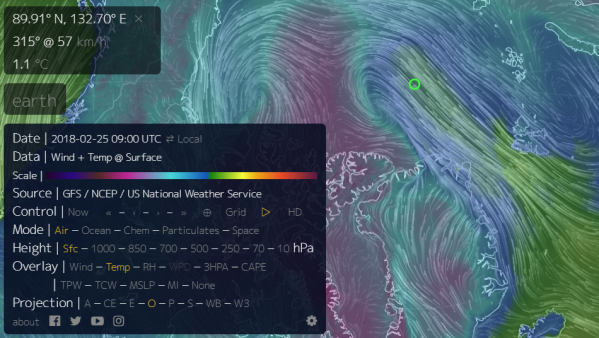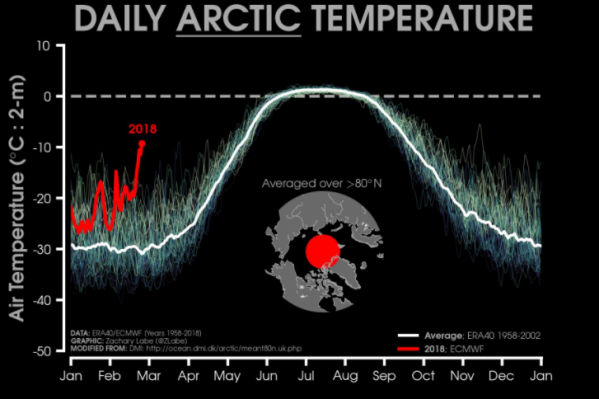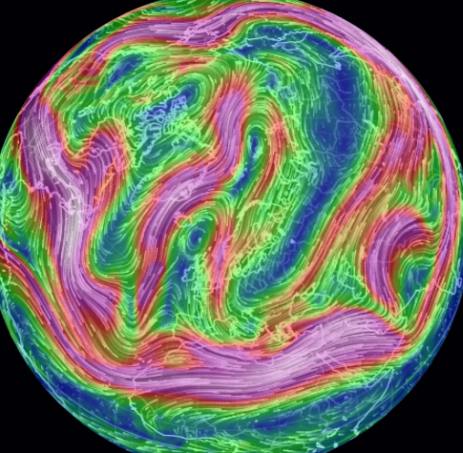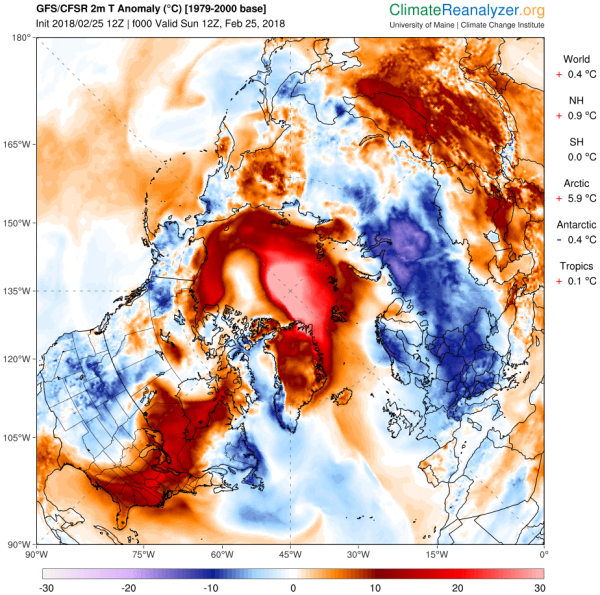A Hole in Winter’s Heart: Temperatures Rise to Above Freezing at the North Pole in February
“Weather is not Climate.”
But when a warm air influx carves a wide-ranging above-freezing hole into the heart of what should typically be ice-solid Arctic winter, then maybe it’s time to start re-evaluating the gist of the statement.
(Today, on Sunday February 25, 2018 at 0900 UTC — temperatures rose to above freezing at the North Pole. This event, which is probably unprecedented or, at the very least, an extreme instance in the polar record, is an exemplar — or a good example — of the kinds of wrenching weather changes we can expect as a result of human-caused climate change. Image source: Earth Nullschool. Data source: Global Forecast System Model.)
Weather and climate are inexorably married one to the other. Though weather is often variable and tied to locality, climate is broader-ranging and roughly characterized as average weather over 30 years. When climate changes, it ultimately changes average weather. It thus changes the rules in which weather occurs. So you can end up with weather events that are typically not common or have never been seen before — like category six hurricanes, much more heavy rainfall events, historic and unprecedented droughts, and above freezing temperatures at the North Pole during February even as Arctic air is driven south over Europe.
In the context of climate change, what we’re talking about is average global weather across the span of multiple decades. In some locations, this ongoing climate change has resulted in very little perceptible weather change. In other locations, and this is more and more-so the case, the changes to weather are both disruptive and profound.
- Climate = weather averaged over 30 years approx. Weather = variable. Climate = mean. Climate change forces regression to new mean, but also forces weather change within new boundaries defined by climate. Out of climate context, single weather events can be cherry picked.1 antwoord0 retweets1 vind-ik-leuk
Als antwoord op @robertscribbler
Single weather events can also be used as exemplars - good examples - of what changes are characteristic of climate change, including heat events, fires, extreme storms, winter warming, the changing of seasonal timing, the redistributions of ocean ecosystems.
0 antwoorden5 retweets11 vind-ik-leuks
We could say that they are, as Dr. Sarah Myhre noted in our little climate and weather chat yesterday, exemplars — or good examples of alterations that are characteristic of human-caused climate change.
******
Since late January, we’ve been tracking the potential for just such an exemplar extreme weather event — temperatures rising to above freezing at the North Pole during February.
The persistent weather patterns necessary for such an event were already well in play. At the surface, warm air was continuously running northward just east of Greenland — born pole-ward by powerful storms and frontal systems. At the upper levels of the atmosphere, a huge plug of warm air was developing. One that invaded the stratospheric levels of the atmosphere by the week of February 4-11. This plug, in synergy with surface warming, tore apart the heart of cold at the roof of our world that we call the Polar Vortex.
(Daily mean temperatures for the entire region of the Arctic above the 80 degree north latitude line rocketed upward to new records over recent weeks. Most recent temperatures are comparable to those typically seen during late May. Image source: Zachary Labe, Arctic Temperatures.)
Nodes of cold air from the remnant Polar Vortex spiraled south — bearing with them regional packets of Arctic air and setting off extreme cold weather in the middle latitudes. Meanwhile, the polar zone just kept warming up into ranges that were increasingly uncharacteristic of Arctic winter.
An extreme wave in the Jet Stream was developing and elongating over the North Atlantic, delivering more and more warm air northward.
By February 21st, the wave had extended into a knife-like extension east of Greenland and through the Barents Sea. Beneath this abnormal Jet Stream wave, which was starting to look more and more like a trans-polar river (of a kind predicted by Dr. Jennifer Francis as a result of human-caused Polar Amplification), was an intensifying thrust of outlandishly warm surface air.
(Jet stream wave originating near Spain extends northward past the North Pole on Sunday, January 25, 2018. Image source: Earth Nullschool.)
Over the past 72 hours, gale force warm, southerly winds gathered in the Atlantic, then blasted north.
At this point, we were starting to see some seriously outlandish temperatures in the higher latitude regions. Cape Morris Jesup, which is the furthest north location on Greenland, by Friday the 23rd experienced 6 C or 43 F temperatures on the shores of what should be a frozen solid Arctic Ocean just 400 miles from the North Pole.
The average high temperature in Cape Morris Jesup is -20 degrees Fahrenheit during February — making Friday’s reading a whopping 63 degrees F warmer than average. For reference, a similar departure for Washington, DC would produce a 105 degree day in February.
But it wasn’t just Cape Morris Jesup that was experiencing July-like conditions for the Arctic during February. For the expanding front of that ridiculously warm winter air by Sunday had expanded into a plume stretching tens of thousands of square miles and including a vast zone of temperatures spiking from 45 to 54+ degrees F above normal.
(The zone of pink-to-white in the above anomaly map shows temperatures ranging from 45 to 54 F [25 to 30 C] above average directly over a broad Arctic region centering on the North Pole. To this weather and climate observer, it looks like a hole in the heart of winter. Also note the region of cold air pushed south over Europe and the present above average [1981-2010] global reading. Image source: Climate Reanalyzer.)
And at the center of the warm air pulse was today’s earlier reading of 1.1 C or 34 F at the North Pole (see image at top of post). What would typically be a summer-time temperature for this furthest north location of our world happening during February. A highlight warm point in the midst of a vast plug of far warmer than normal air. A hole in the heart of winter.
We’ll wait for confirmation from experts like Chris Burt, Bob Henson, and Dr. Jeff Masters at Weather Underground, but it appears that this particular warming event — the highlight of an ongoing polar warming of the past few weeks — is without precedent in the Arctic during February. It is also an exemplar — a good example — of the kind of weather we can expect to frequent the Arctic more and more often as the global crisis that is human-forced climate change deepens and as its primary cause — fossil fuel burning — continues.
(Please also see Neven’s related excellent expert analysis of this unprecedented polar warming event at the Arctic Sea Ice Blog here. More to follow on impacts to sea ice in a developing post.)


















Geen opmerkingen:
Een reactie posten